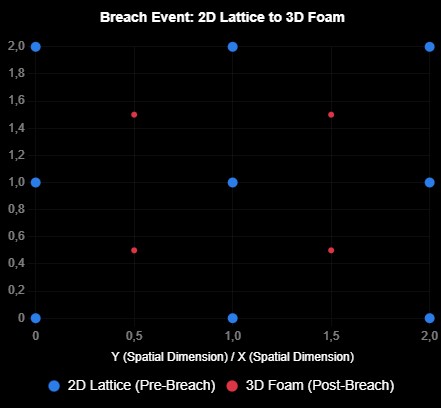The Breach Event in Pattern Field Theory™
Date: August 28, 2025
- NULL ≠ 0: no domain, no metric, no numbers.
- Emergence: geometry turns on; with the first curvature, π emerges as its invariant.
- Π‑particle: first coherent loop with \(\oint \kappa\,ds=2\pi\); Π‑matrix enforces π‑locking.
- Breach (2D→3D): a supercritical instability — bamboo‑like, staccato chain reaction. Not a “controlled rupture.”
Overview
The breach is the geometric transition from a coherent 2‑D sheet into 3‑D volume. It is triggered when the sheet’s size–tension–potential crosses a threshold; many long‑wavelength modes ignite at once, creating rims that circularize quickly. Since π emerges at Emergence, rims are π‑locked (\(\oint\kappa\,ds=2\pi\)).
A) Supercritical instability (not “controlled rupture”)
When the 2‑D sheet grows large enough and the stored tension + potential cross a threshold, long‑wave modes go unstable together — a bamboo‑like, staccato chain reaction that lifts into 3‑D. A minimal free‑energy captures the onset:
Once L > Lcrit, many modes ignite at once → chain reaction. Rim segments circularize under tension, so π governs the rims.
B) Breach instability criterion (details)
Let \(h(x,y)\) be the out‑of‑plane displacement of the coherent 2‑D sheet. With bending rigidity \(\kappa\), surface tension \(\sigma\), and effective potential \(\alpha>0\), linear modes \(h_{\mathbf k}\) grow if
After nucleation, rim tension drives curvature toward a constant value, making the loop π‑locked: \(\oint \kappa\,ds = 2\pi\).
C) Front‑page callout (drop‑in)
Not a controlled rupture: the 2‑D sheet crosses a size–tension–potential threshold and undergoes a supercritical instability — a bamboo‑like, staccato chain reaction into 3‑D. See instability criterion.
D) Breach instability — testable signatures
- Size scaling: onset frequency vs domain size jumps at \(L=L_{\text{crit}}\).
- Rim circularization: rapid drop in curvature variance; \(R_\pi=\big|\sum\kappa_i\Delta s_i-2\pi\big|\to 0\).
- Mode band: initial rupture wavelengths confined to \(0<k<k_c\); spectral histogram cuts off near \(k_c\).
Π‑locking metrics (for rims)
- Closure residual: \(R_\pi=\big|\sum_i \kappa_i \Delta s_i - 2\pi\big|\).
- Curvature variance: length‑weighted \( \mathrm{var}_w(\kappa) \).
- Π‑matrix stability: smallest eigenvalue \( \lambda_{\min}(\mathbf H_\pi) \) of the π‑locking Hessian.
Acceptance band (tunable): candidates typically have \(R_\pi \lesssim 10^{-2}\), low variance, and small positive \( \lambda_{\min} \).
Diagram: Genesis of the Breach
- Flat 2D sheet: coherent layer under tension.
- Strain builds: long‑wave modes soften as \(L \to L_{\text{crit}}\).
- Ignition: many modes fire (staccato); rims nucleate.
- Circularization: rims tend toward constant curvature (π‑locking).
- 3D foam: volumetric structures appear; mixed 1D/2D residues persist.

Artifacts & Repos
- results/breach_imprints.json (placeholder)
- results/cmbr_metrics.json (placeholder)
- Proposed GitHub:
References (context/analogy)
- Mattei & Milton (2017), “Field patterns without blow up,” New J. Phys. — cited for analogy only; not PFT.
- Caloz et al. (2020), “Spacetime Metamaterials — Part I,” IEEE TAP — general context on time‑varying media.
Trademarks: Pattern Field Theory™ (PFT™) and related marks are claimed trademarks. © James Johan Sebastian Allen.